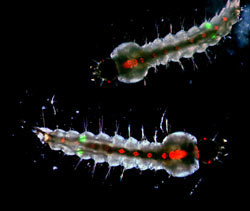Malaria 2
Malaria is the world’s most common and deadly parasitic disease. The World Health Organization estimates that each year 300-500 million cases of malaria occur and more than half a million people die of malaria. A possible breakthrough in curtailing the spread of malaria carrying mosquitoes was reported in October 2005 the creation of mosquitoes with green fluorescent testicles. Now male mosquito larvae (see picture above) can easily be separated from female mosquito larvae. Without green fluorescent gonads it is impossible to separate mosquito larvae based on their sex, and it is very difficult to separate the adults since they fly about and bite (actually only the females bite). Now a laser sorting machine has been developed that can sort 180,000 larvae in 10 hours. Once separated from the females it is trivial to sterilize the males and release them into the environment where they will mate with wild females. Female mosquitoes only mate once in their two-week cycle, so if they chose a sterilized male they will produce no offspring. If a large enough population of sterilized males is released into the wild population should be eradicated in a fairly short time. Controlling individual neurons
